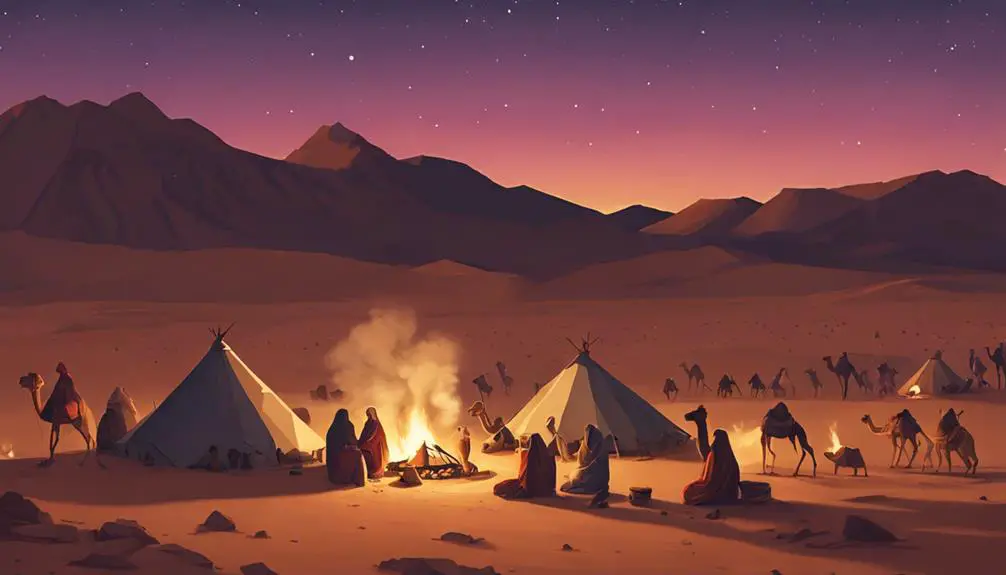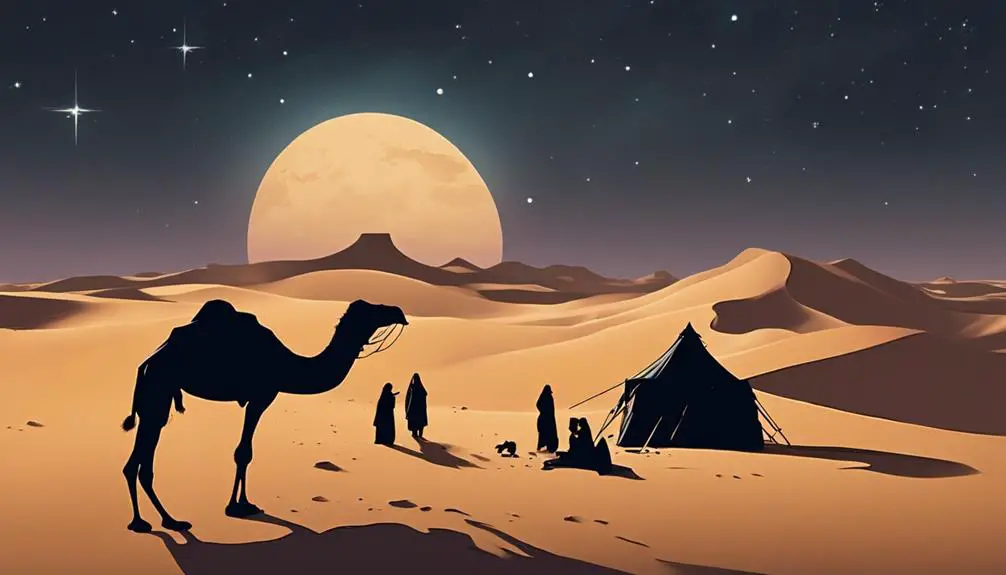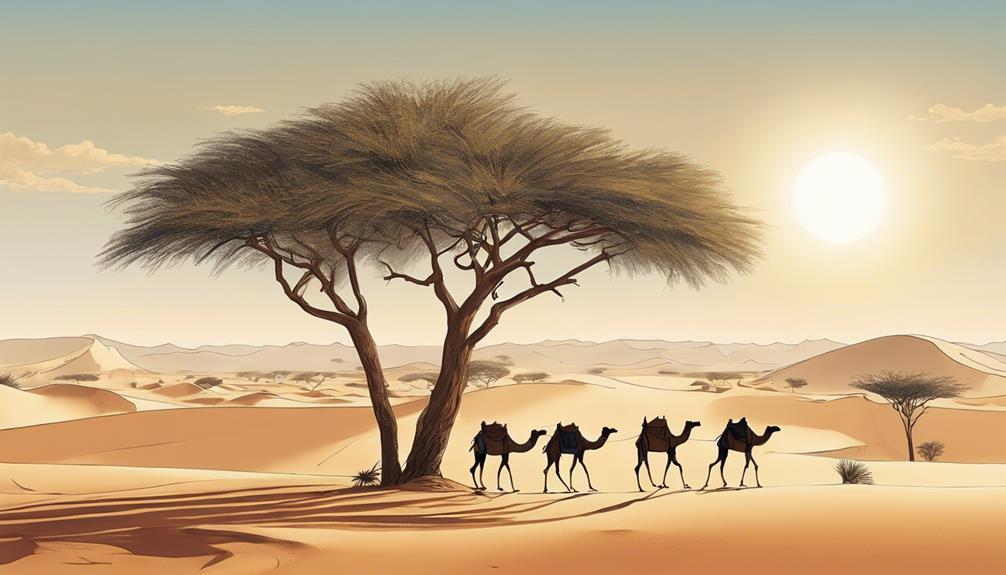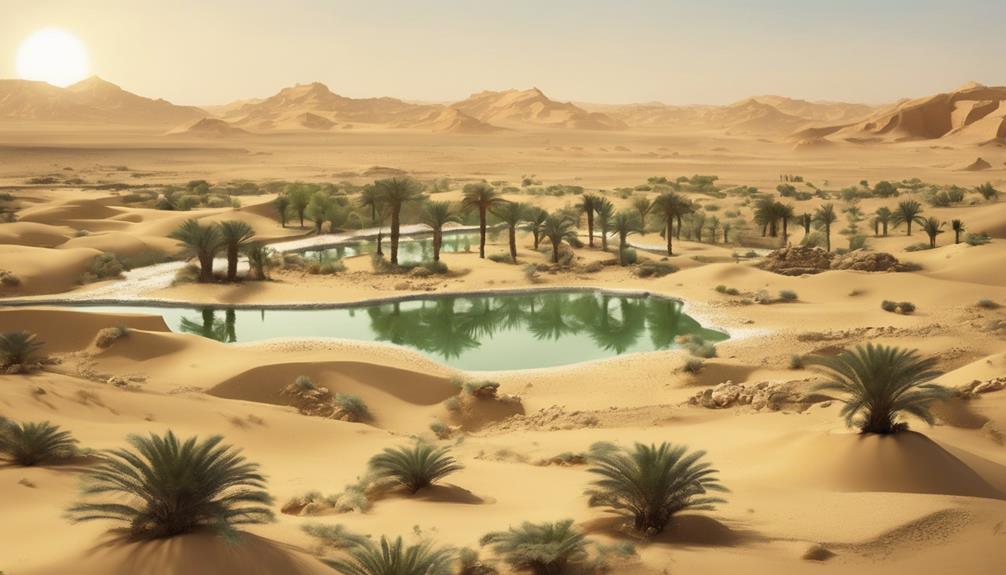Uncover the ancient names of what is now Saudi Arabia, as mentioned in the Bible, and delve into their historical and religious significance.

What Was Saudi Arabia Called in the Bible
Imagine walking through the vast, sun-drenched deserts of what we now know as Saudi Arabia, a land steeped in biblical history yet called by different names in ancient scripts.
You're about to embark on a journey back in time, exploring territories like the Land of Midian and the Kingdom of Sheba, lands mentioned in sacred texts but not immediately recognizable on a modern map.
These names, each with its own story and significance, prompt intriguing questions about their historical and religious context.
Let's uncover the mysteries that these ancient names hold, uncovering a past that bridges the gap between scripture and the geographical landscape of today.
Key Takeaways
- The Land of Midian, associated with northwestern Saudi Arabia, is prominently featured in biblical narratives.
- Territories of the Ishmaelites covered parts of the Arabian Peninsula, linking to ancestral stories of Abraham.
- The Kingdom of Sheba, known for its prosperity and the Queen's visit to Solomon, hints at ancient Yemen's location.
- Havilah, recognized for its resources such as gold, is mentioned in biblical texts, suggesting historical wealth in the region.
The Land of Midian

The Land of Midian, often associated with regions in northwestern Saudi Arabia, holds a pivotal role in biblical narratives, serving as a geographical and cultural bridge in ancient times. You'll find that this area isn't just a backdrop for some of the Bible's most compelling stories; it's a crossroads of ancient civilizations. It's where Moses sought refuge after fleeing Egypt, marking a significant chapter in his life and in the broader story of the Israelites. This desert land, rugged and remote, provided Moses not only a place to escape Pharaoh's wrath but also a new beginning.
In Midian, Moses' life took a pivotal turn. He married Zipporah, a native of this land, making Midian not just his refuge but also his adopted homeland. This marriage symbolizes the deep connections formed between Moses and the Midianite people, further intertwining the destinies of different cultures and peoples in the biblical narrative. The detail here isn't just about geographical or historical context; it's about understanding the profound human and divine interactions that shaped the course of biblical history. Analyzing Midian's role illuminates the complex tapestry of relationships, faith, and survival in ancient times.
Territories of Ishmaelites

Delving into the biblical narrative, you'll find that Ishmaelites, descendants of Abraham and Hagar, established their territories strategically across what's now known as the Arabian Peninsula, playing a crucial role in the fabric of ancient Middle Eastern societies. These desert dwellers, primarily nomadic tribes, adapted seamlessly to the harsh environments, mastering the art of survival in vast, uninhabitable spaces. Their territories, while not defined by the fixed borders seen in modern geopolitics, were delineated by natural landmarks and seasonal migration patterns, ensuring access to scarce resources such as water and grazing land for their livestock.
The Ishmaelites' way of life, deeply entwined with their environment, fostered a culture rich in oral traditions, poetry, and a profound understanding of the desert's ecology. This intimate relationship with the land allowed them to navigate and control trade routes that connected the ancient civilizations of Mesopotamia, the Levant, and Egypt. Their knowledge of the terrain and strategic positioning made them invaluable as traders and carriers of goods, ideas, and cultures across the region, cementing their legacy as pivotal players in the ancient Near East's socio-economic networks.
The Kingdom of Sheba

ARTICLE TITLE: Saudi Arabia in the Bible
PREVIOUS SUBTOPIC: 'Territories of Ishmaelites'
CURRENT SUBTOPIC: 'The Kingdom of Sheba'
While exploring the intricate networks that defined the ancient Near East, it's essential to examine the Kingdom of Sheba, whose influence and prosperity were profound in the region's geopolitical and economic landscapes. Central to its narrative is Queen Sheba's visit to King Solomon, showcasing the kingdom's significance in ancient diplomacy and wisdom exchange.
Aspect |
Description |
Importance |
|---|---|---|
Trade Routes |
Lifelines of Sheba's economy |
Facilitated wealth and cultural exchange |
Queen Sheba |
Emblematic leader |
Symbolized wisdom and diplomatic prowess |
Economic Power |
Result of strategic location |
Ensured prosperity through trade |
Cultural Impact |
Influence beyond borders |
Spread of knowledge and customs |
Sheba's strategic position on vital trade routes not only bolstered its economy but also positioned it as a key player in the exchange of goods, ideas, and culture across continents. This intersection of wealth and wisdom underpinned the kingdom's legacy, highlighting its role in fostering an interconnected world long before the term globalization was conceived. Queen Sheba's visit to Solomon epitomizes this era of rich cultural and economic interplay, marking Sheba's indelible imprint on the historical and biblical narrative.
Wilderness of Paran

Navigating through the biblical narratives, you'll discover that the Wilderness of Paran plays a pivotal role in the history of the Israelites, serving as both a physical and spiritual landscape of transition and testing. This expansive desert, characterized by its harsh desert climate, symbolizes a place of refuge, punishment, and divine encounter. The arid conditions and the vast, unyielding terrain underscore the challenges faced by the Israelites as they wandered for 40 years, relying on divine providence for sustenance and guidance.
Analyzing the biblical routes, it's evident that the Wilderness of Paran served as a critical juncture for the Israelites, connecting the Sinai Peninsula with the lands to the north. This geographical positioning made Paran a key passageway in the biblical narrative, illustrating the strategic importance of desert regions in ancient times. The harsh landscape tested the faith and resilience of the Israelites, shaping their identity and destiny as God's chosen people.
In the broader context of biblical geography, the Wilderness of Paran exemplifies the intricate relationship between the physical environment and divine narrative, highlighting how desert climates influenced the spiritual journey of the Israelites and the unfolding of biblical history.
Havilah and Its Resources

Shifting our focus from the austere Wilderness of Paran, we now explore Havilah, a region celebrated for its abundant resources and significant contributions to ancient economies. Havilah's strategic positioning near pivotal river civilizations catalyzed its development, facilitating trade and cultural exchanges that were vital for the prosperity of the region.
- Gold Extraction: Havilah was renowned for its gold, noted in ancient texts as being of exceptional quality. The meticulous methods developed for gold extraction underscored the advanced technological understanding of its inhabitants.
- River Civilizations: The proximity to major rivers not only boosted Havilah's agricultural capabilities but also positioned it as a crucial node in the trade networks that connected diverse cultures and economies.
- Economic Contributions: The wealth generated from gold and trade elevated Havilah's status among ancient economies, allowing it to influence regional politics and commerce significantly.
- Cultural Exchanges: The interaction with neighboring river civilizations led to a rich tapestry of cultural exchanges, from technological innovations to linguistic and religious influences, shaping the identity and legacy of Havilah.
Through these elements, Havilah emerges as a pivotal region, its resources and strategic location fostering a unique blend of prosperity, power, and cultural depth.
Frequently Asked Questions
How Does the Modern-Day Geography of Saudi Arabia Correlate With the Ancient Biblical Locations Mentioned in Texts?
You're exploring how Saudi Arabia's present geography aligns with ancient biblical sites. Geological formations and climate change over millennia have transformed landscapes, potentially altering locations' identifiability.
Historically, shifts in climate could have led to drastic environmental changes, affecting how we correlate modern Saudi Arabia with biblical narratives. Analyzing these factors requires a detailed, scholarly approach, considering how ancient texts describe geographical features and comparing them with today's maps and climate data.
Were There Any Significant Archaeological Discoveries in Today's Saudi Arabia That Support Its Mentions in the Bible?
Yes, there've been significant archaeological discoveries in today's Saudi Arabia that lend credibility to its mentions in the Bible, enhancing its historical authenticity.
These findings not only corroborate ancient texts but also enrich our understanding of cultural symbolism tied to biblical narratives.
Through detailed, scholarly analysis, these discoveries help bridge the gap between scriptural stories and tangible evidence, offering a deeper insight into the region's historical and religious landscape.
How Did the Biblical Depiction of These Regions Influence the Cultural and Religious Practices of Ancient Communities Within Them?
You'll find that the biblical depiction of regions now known as Saudi Arabia significantly influenced ancient communities' cultural and religious practices. This influence often led to cultural assimilation and religious syncretism, as locals merged their traditions with those introduced through biblical narratives.
This blending created a rich, diverse cultural landscape, where practices from various origins coexisted and evolved. Such historical intersections highlight the profound impact of religious texts on cultural evolution and identity formation.
Can Any of the Ancient Trade Routes Mentioned in the Bible Be Traced Through Modern-Day Saudi Arabia?
Yes, you can trace some ancient trade routes mentioned in the Bible through modern-day Saudi Arabia. These routes, often traveled by camel caravans, were crucial for the spice trade, connecting various civilizations.
As you delve deeper, you'll find that these pathways not only facilitated commerce but also cultural exchanges, significantly influencing the region's development. Analyzing these routes offers a glimpse into the complex trade networks that shaped early human history.
How Do Contemporary Religious Scholars Interpret the Role of These Biblical Locations in the Context of Modern-Day Faith and Spirituality?
You're exploring how contemporary religious scholars view ancient biblical locations' roles in today's faith and spirituality. They delve into scriptural translations to understand these sites' spiritual significance, fostering a scholarly, analytical approach.
Through interfaith dialogues, they examine the interconnectedness of these holy places across different religions, enriching modern spirituality.
Their work highlights the evolving nature of faith, showing how historical contexts shape contemporary religious beliefs and practices.
Conclusion
In conclusion, your exploration into the biblical names for the region now known as Saudi Arabia reveals a complex tapestry of historical and cultural layers. From the Land of Midian to the territories of the Ishmaelites, and from the opulent Kingdom of Sheba to the desolate Wilderness of Paran, each name reflects distinct narratives and resources, such as Havilah's riches.
These names not only denote geographical locations but also embody significant historical, economic, and spiritual dimensions of ancient Near Eastern civilizations.



Sign up